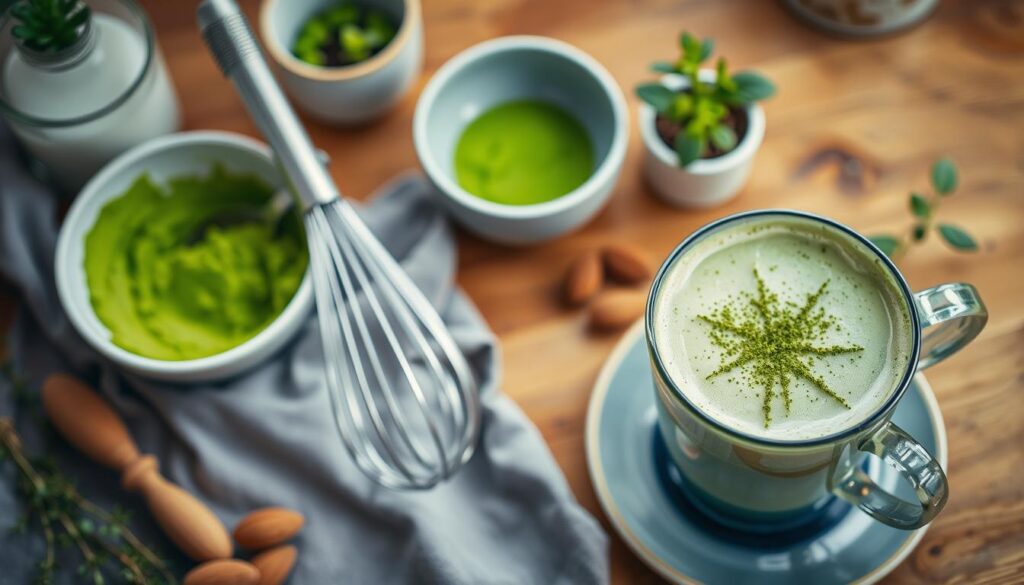Making the perfect homemade matcha latte is like a fun art project. It turns your kitchen into a fancy cafe. Getting that smooth froth like in restaurants might seem hard, but it’s easy with the right tips.
More than just saving money, making your own matcha latte lets you control your drink. You can pick the best matcha powder and learn how to froth it perfectly. This guide will show you how to make a froth that’s as good as any coffee shop’s.
Whether you love matcha or are just starting, these tips will make your homemade latte creamy and delicious. You’ll be amazed at how easy it is to make a top-notch matcha latte at home.
Key Takeaways
- Master the art of homemade matcha latte preparation
- Learn professional frothing techniques
- Understand the importance of high-quality matcha
- Customize your green tea latte experience
- Save money by creating cafe-quality drinks at home
Understanding Matcha: The Foundation of a Perfect Latte
Making a great matcha latte begins with knowing about matcha quality. Not all matcha powders are the same. The grade you pick can change how your drink tastes, looks, and feels.
Ceremonial vs. Culinary Grade Matcha
Matcha grades are key to a latte’s quality. There are two main types:
- Ceremonial Grade Matcha: The top quality, perfect for tea ceremonies and drinking on its own
- Culinary Grade Matcha: Good for cooking, baking, and drinks like lattes
The Role of Matcha Quality in Taste
Higher quality matcha means a richer taste and smoother latte. Premium matcha has a deep flavor with a hint of umami and little bitterness.
| Matcha Grade | Flavor Profile | Best Use |
|---|---|---|
| Ceremonial Grade | Smooth, sweet, delicate | Traditional tea, premium lattes |
| Culinary Grade | Stronger, more robust | Cooking, mixed beverages |
Storage and Freshness Tips
Keeping matcha fresh is crucial for its taste and health benefits. Here’s how to keep it fresh:
- Store in an airtight container
- Avoid light and heat
- Refrigerate unopened packages
- Use within 4-6 weeks after opening
“The quality of your matcha determines the soul of your latte” – Japanese Tea Master
Learning about matcha grades, quality, and storage will make your latte truly special.
Essential Tools and Equipment for Matcha Preparation
Making the perfect matcha latte needs more than just great matcha powder. The right tools can make your home brewing better and improve your drink’s taste.
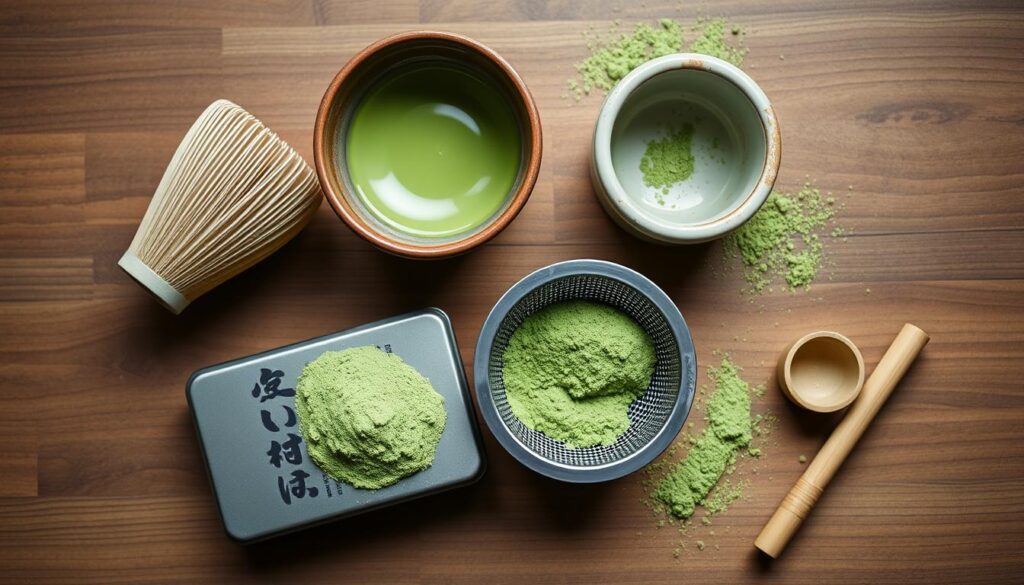
Every matcha lover needs a few key pieces to make a real and tasty drink. Let’s look at the essential tools for a top-notch matcha latte.
- Bamboo Whisk (Chasen): The traditional matcha whisk is key for mixing powder and making it smooth and frothy
- Matcha Bowl (Chawan): A wide ceramic bowl made for whisking and serving matcha
- Matcha Sifter: Removes powder lumps for a silky drink
- Electric Frother: A modern way for quick and even frothing
“The right tools can transform an ordinary matcha into an extraordinary experience.”
When picking your matcha tools, think about these traditional and modern options:
| Tool | Traditional Method | Modern Alternative |
|---|---|---|
| Whisking | Bamboo whisk (chasen) | Electric frother |
| Mixing | Manual sifting | Automatic sifter |
| Serving | Ceramic matcha bowl | Various mugs and glasses |
Good matcha tools really boost your brewing skills. A bamboo whisk and matcha bowl give a true experience. An electric frother is handy for quick mornings.
The Science Behind Perfect Matcha Frothing
Mastering matcha frothing is all about milk proteins and temperature control. It’s not just about mixing ingredients. It’s a blend of molecular chemistry and traditional techniques.
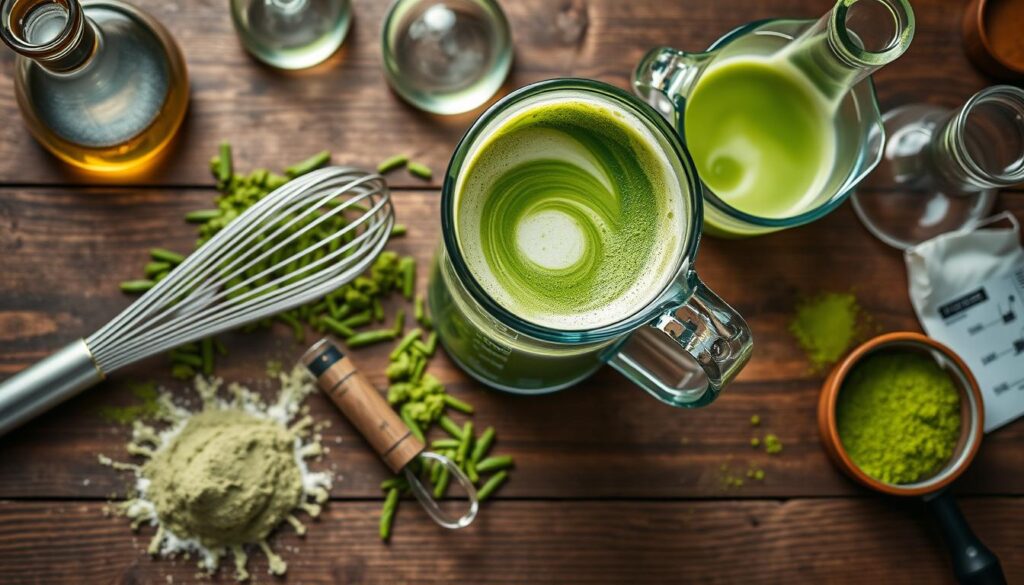
Matcha frothing science shows us how milk changes during preparation. The protein structure in milk is key to getting that smooth, creamy texture everyone loves.
Temperature Control Fundamentals
The right milk temperature is crucial for perfect froth. Temperatures between 140-160°F are ideal. They help milk proteins unfold and create stable bubbles for that signature texture.
- Ideal milk temperature: 150°F
- Too cold: Flat, lifeless froth
- Too hot: Protein breakdown and burnt taste
Milk Protein Structure and Frothing
When milk heats up, its proteins start to change. The right heat and technique are what make your matcha latte’s foam great.
| Milk Protein Type | Frothing Capability | Best Temperature Range |
|---|---|---|
| Casein | High stability | 140-155°F |
| Whey | Quick expansion | 145-160°F |
Why Traditional Methods Work Best
Traditional matcha methods have proven their worth. Bamboo whisks and precise temperature control lead to better protein interaction and foam.
“The secret to perfect matcha is respecting its ancient preparation methods while understanding modern food science.” – Matcha Expert
Selecting the Right Milk for Your Matcha Latte
Choosing the right milk can make your matcha latte amazing. Different milks change the taste, texture, and feel of your drink.
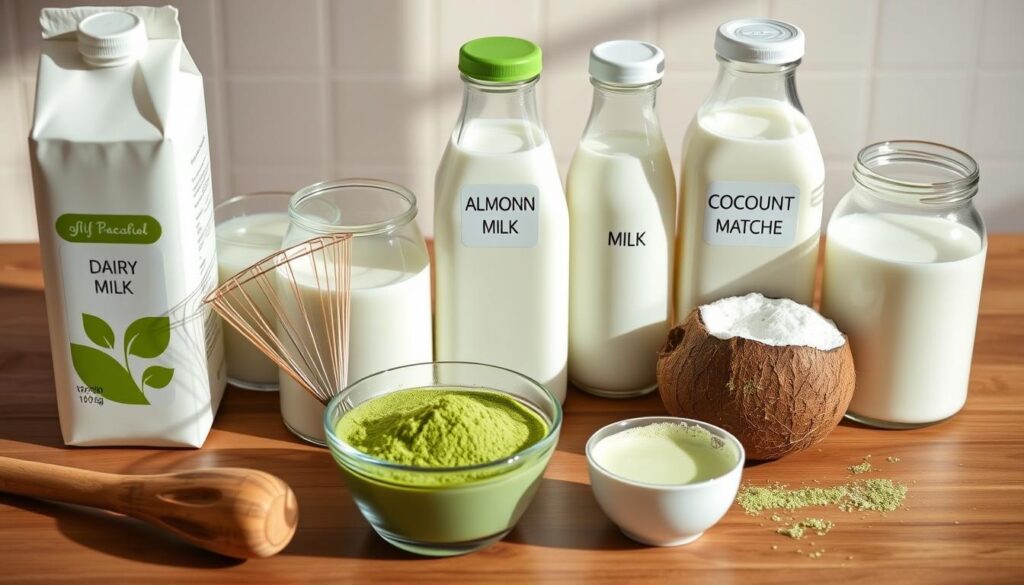
When looking at dairy alternatives for matcha, think about these things:
- Protein content
- Fat percentage
- Frothing capabilities
- Flavor compatibility
Plant-based milks for matcha have special benefits. Oat milk is a great choice for frothing. It gives a creamy texture and a hint of sweetness that goes well with matcha’s earthy taste.
| Milk Type | Froth Quality | Flavor Profile |
|---|---|---|
| Whole Milk | Excellent | Rich, Creamy |
| Oat Milk | Very Good | Neutral, Slightly Sweet |
| Almond Milk | Fair | Nutty, Light |
| Soy Milk | Good | Neutral, Protein-Rich |
“The secret to a perfect matcha latte lies in selecting milk that enhances, not overwhelms, the delicate matcha flavor.”
For the best matcha latte, try different milks. Each one adds its own special touch, making your latte unique to you.
Pro tip: Warm your milk to around 140-160°F for optimal frothing and flavor development.
DIY Matcha Lattes: Tips for Getting the Perfect Froth
Making a tasty matcha latte at home needs special matcha whisking skills. These skills turn your drink into something amazing. It’s not just about mixing stuff together. It’s about being precise, using the right techniques, and knowing the process well.
Mastering Whisking Techniques for Optimal Results
For the best matcha froth, the correct whisking method is key. Baristas suggest using a bamboo whisk (chasen) with certain motions:
- Start with a W-shaped whisking motion
- Maintain a consistent wrist rhythm
- Keep the whisk at a 45-degree angle
- Whisk quickly but smoothly
Avoiding Common Matcha Latte Mistakes
To get perfect matcha foam, avoid common mistakes. These mistakes can ruin your drink’s quality. Some big mistakes include:
- Using water that’s too hot
- Whisking too slowly
- Using low-quality matcha powder
- Failing to sift the matcha powder
Crafting Restaurant-Quality Foam at Home
Creating restaurant-quality foam is all about the details of matcha making. Practice your whisking, get good tools, and remember, consistency is crucial for the best froth.
“The secret to an exceptional matcha latte lies in the technique, not just the ingredients.” – Matcha Expert
Alternative Frothing Methods and Tools
Creating the perfect matcha latte is more than just whisking. Today, coffee lovers use new tools to make creamy, smooth foam.
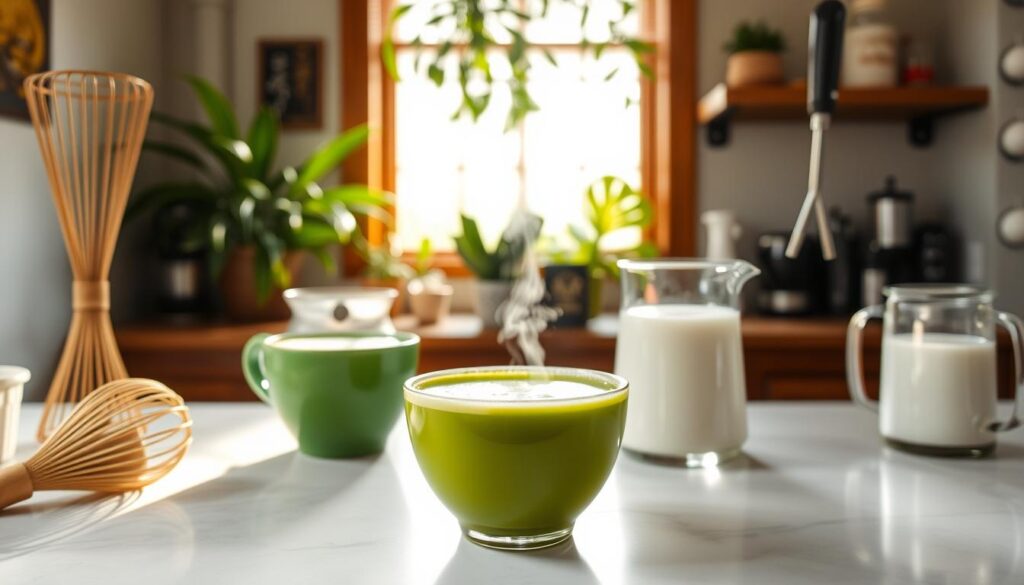
- Electric milk frother: Quick and consistent foam generation
- Hand frother: Portable and budget-friendly option
- French press frother: Versatile manual technique
- Blender frothing: High-volume foam production
The electric milk frother is perfect for home baristas. It’s fast and precise, making microfoam ideal for latte art.
| Frothing Tool | Pros | Cons |
|---|---|---|
| Electric Milk Frother | Fast, consistent results | Higher cost, requires electricity |
| Hand Frother | Affordable, portable | Manual effort required |
| French Press | Multi-purpose tool | Less precise foam |
| Blender | Large volume capability | Potential over-frothing |
For restaurant-quality foam, try different frothing methods. Each tool has its own benefits, helping you find your favorite way to make matcha lattes.
“The right frothing tool can transform an ordinary matcha latte into an extraordinary beverage.” – Matcha Enthusiast
Customizing Your Matcha Latte Experience
Making the perfect matcha latte is all about personal touch. Every tea enthusiast can make their drink special by trying out new ingredients and methods.
Sweetener Options for Matcha Perfection
Finding the right sweetener is key to matcha’s taste. Here are some top picks:
- Honey: Natural sweetness with floral undertones
- Agave nectar: Smooth, mild flavor profile
- Maple syrup: Rich, complex sweetness
- Stevia: Zero-calorie plant-based option
Hot vs. Iced Matcha Latte Variations
Matcha latte fans can enjoy it hot or iced. Each way brings a different taste:
| Hot Matcha Latte | Iced Matcha Latte |
|---|---|
| Creamy, smooth texture | Refreshing, light consistency |
| Ideal for winter months | Perfect summer beverage |
| Traditional preparation method | Modern, trendy approach |
Creative Flavor Enhancement Ideas
Try new matcha latte flavors with unique ingredients:
- Cinnamon for warm spice
- Lavender for subtle floral notes
- Vanilla extract for classic sweetness
- Coconut milk for tropical twist
“The beauty of matcha is its versatility – each sip can be a new adventure!” – Tea Enthusiast
Pro tip: Start with small quantities when experimenting with new flavor combinations to find your perfect matcha latte profile.
Troubleshooting Common Matcha Latte Problems
Making the perfect matcha latte can be tricky. To fix common issues, it helps to know what problems home brewers face. We’ll look at how to fix froth and tackle flavor and consistency problems.
Matcha latte consistency can be a challenge. Here are the main issues and how to solve them:
- Clumpy Matcha: Sift your matcha powder before whisking to avoid lumps. Use a fine mesh strainer to get rid of clumps.
- Weak Froth: Get a good bamboo whisk and whisk in a ‘W’ motion to make better foam.
- Matcha Latte Bitterness: Use cooler water (around 175°F) and high-quality ceremonial grade matcha to lessen bitterness.
“Perfect matcha is an art of precision and technique” – Matcha Master
Water temperature is very important in making matcha. Water that’s too hot can burn the matcha, making it taste bitter. Always use water between 160-180°F for the best taste.
Using fresh matcha helps avoid consistency and flavor problems. Keep your matcha in an airtight container, away from light and heat. Replace it every 1-2 months for the best flavor and quality.
- Check matcha color: Bright green means it’s fresh
- Smell the powder: Fresh matcha smells grassy and sweet
- Don’t store it near strong-smelling foods
With these tips, you’ll get better at making matcha lattes like a pro. Remember, practice makes perfect!
Conclusion
Making the perfect matcha latte is an art that needs skill, quality ingredients, and passion. By learning about matcha frothing, you can turn your kitchen into a cozy café. This guide gives you the tools to make matcha drinks as good as those from a professional barista.
Quality is key to a great matcha latte. Choosing the best ceremonial grade matcha and mastering whisking are crucial. Trying different milks, temperatures, and frothing methods lets you make your drink just right.
Practice is essential. Every time you make a matcha latte, you get better at balancing ingredients and techniques. Don’t worry if it’s not perfect at first. See it as a chance to improve and enjoy the process.
Your quest for the perfect matcha latte is a tasty journey of learning and fun. With patience, curiosity, and what you’ve learned here, you’ll soon be making café-quality lattes at home.
FAQ
What’s the difference between ceremonial and culinary grade matcha?
Ceremonial grade matcha is top-notch, made from young tea leaves. It’s for tea ceremonies and has a soft, green flavor. Culinary grade is stronger and cheaper, great for cooking and lattes.
How do I know if my matcha is fresh?
Fresh matcha is bright green and smells rich. Check the date on the packaging. Store it in a sealed container away from light and heat. Use it within 1-2 months for the best taste.
Can I make a matcha latte without a traditional bamboo whisk?
You can use other tools like electric milk frothers or blenders. But, a bamboo whisk makes the drink smoother.
What type of milk works best for a matcha latte?
Whole milk makes the froth creamiest. Oat and almond milk are good alternatives. Avoid skim milk for better foam.
Why does my matcha latte taste bitter?
Bitterness comes from hot water, whisking too hard, or bad matcha. Use 175°F water, sift the matcha, and choose high-quality ceremonial grade.
How can I make an iced matcha latte?
Whisk matcha with hot water, then pour over ice and add cold milk. Or shake it in a shaker for a frothy drink.
What sweeteners work well with matcha?
Honey, agave, and maple syrup are good. Simple syrup is also great. Start with a little and adjust to taste.
How much matcha should I use for a latte?
Use 1-2 teaspoons of matcha per 8-12 ounces of milk. For a stronger taste, use 2 teaspoons. Always sift the matcha for a smooth latte.
Share this post: on Twitter on Facebook

